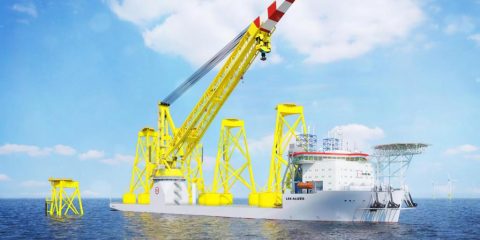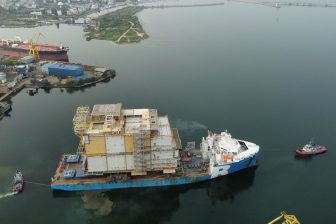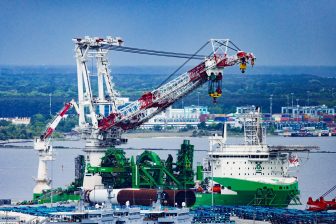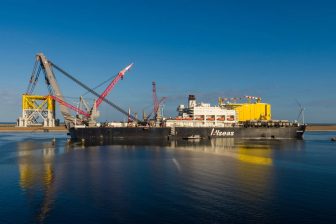
Construction of Jan de Nul’s new 5,000-tonne crane vessel begins
PRESS RELEASE – Construction of Jan De Nul’s new 5,000-tonne crane vessel Les Alizés has begun. The steel cutting ceremony took place last week at shipyard China Merchants Heavy Industry. After thirteen months of preparation, designing and planning, Jan De Nul Group says it’s happy to reach this milestone.
Les Alizés will mainly be used for the construction of offshore wind farms, but with her powerful crane, she is also suitable for decommissioning offshore oil and gas platforms. Thanks to her dimensions and lifting and loading capacities, Les Alizés will be able to load out, transport and install multiple units of the largest and heaviest wind turbine foundations. As a crane vessel that floats, it will also be able to install heavier and larger foundations into deeper waters and in more challenging seabed conditions.
The main features are a 5,000-tonne main crane, a deck loading capacity of 61,000 tonnes and a deck space of 9,300 square meters. With these characteristics, Les Alizés can easily transport several of the heavier future foundations in one trip, which brings benefits in planning, fuel consumption and emissions reduction.
Unlike Jan De Nul’s other offshore installation vessel under construction Voltaire, Les Alizés does not have four legs to lift itself above the sea surface. It is a crane vessel for floating installation, which means that the vessel is not dependent on the water depths and the seabed conditions. Instead, Les Alizés is equipped with a high-performance DP2 system.
Green technology
Les Alizés will be equipped with exhaust gas filtering technology that complies with the strict European EURO STAGE V guidelines for emissions on land and inland waterways. This exhaust filter system removes up to 99% of nanoparticles from emissions using a diesel particulate filter (DPF) followed by selective catalytic reduction system (SCR) for NOx removal.
Additionally, the crane vessel will be fitted with an Energy Storage System (ESS), forming a hybrid setup together with the main diesel engines. This ESS will compensate power peaks on the main engines and recover energy from the heavy-lift crane, resulting in optimised engine operation and less fuel consumption and emissions.
And finally, Les Alizés will have a Cleanship NDO7 label and a Green Passport EU label. The Cleanship label confirms that the vessel checks and minimizes the wastewater and all other residual waste. The second Green Passport label means that all materials and hazardous substances are mapped out during the construction phase, in order to facilitate the recycling of the vessel when decommissioned. Both certificates are issued by a specialized external agency.
You just read one of our premium articles free of charge
Register now to keep reading premium articles.




